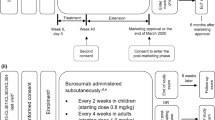Abstract
Purpose
Our aim was to explore whether vitamin A has protective effect on high-dose-methotrexate (HDMTX)-induced intestinal D-xylose malabsorption in children with leukemia and lymphoma.
Patients and methods
We performed a prospective randomized unblinded study of vitamin A in 35 children with leukemia and lymphoma who were planned to receive HDMTX 3 g/m2 and 5 g/m2, respectively. Twenty-two patients (group 1) received a single dose of 180,000 IU a day before HDMTX was given, and 13 (group 2) received only HDMTX. The vitamin A group received the vitamin only once. Oral D-xylose absorption tests before and 7 days after HDMTX were carried out to evaluate intestinal absorption. Retinol-binding protein (RBP) levels prior to therapy were also measured for vitamin A status.
Results
Although we observed no difference of HDMTX-induced toxicity, including hematological, dermatological, systemic, and other toxicities, between groups, the D-xylose absorption test was significantly better in-group 1 (p=0.030). Absorption was decreased in five of 22 patients (23%) who received vitamin A comparing to eight of 13 (62%) who received only HDMTX (p=0.033). RBP levels were lower than normal in 13 of 22 patients in-group 1 and nine of 13 in group 2. In patients whose RBP levels were lower than normal, HDMTX-induced toxicity was lower in the group 1 than group 2 but not statistically significant. No sign of vitamin A toxicity was observed throughout the study.
Conclusion
The administration of vitamin A before HDMTX may protect against drug-induced D-xylose malabsorption in children with cancer. Further studies are apparently needed to clarify the full benefits of vitamin A in preventing HDMTX-induced mucosal damage.


Similar content being viewed by others
References
Almekinder J, Manda W, Soko D, Lan Y, Hoover DR, Semba RD (2000) Evaluation of plasma retinol-binding protein as a surrogate measure for plasma retinol concentrations. Scand J Clin Lab Invest 60:199–203
Balis FM, Holcenberg JS, Poplack DG (1997) General principles of chemotherapy. In: Pizzo PA, Poplack DG (eds) Principles and practice of pediatric oncology, 3rd edn, Lippincot, Philadelphia, pp 215–272
Barclay AJ, Foster A, Sommer A (1987) Vitamin A supplements and mortality related to measles: a randomized clinical trial. BMJ 294(6567): 294–296
Bernard A, Dandrifosse G, Romain N, Forget P (1989) Effect on the intestinal mucosa of PGE2-treated rats. Life Sciences 45:2591–2603
Craig R, Atkinson A (1988) D-xylose testing: A review. Gastroenterology 95:223–231
DeLap R (1996) Antimetabolic agents. In: Kirkwood J, Lotze M, Yasko J (eds) Current cancer therapeutics, 2nd edn, Current Medicina, Philadelphia, pp 50–62
Eledrisi SM, Mc Kinney K Vitamin A toxicity. http://www.emedicine.com/med/topic2382.htm.
Hasan M and Finucane P (1993) Intestinal malabsorption presenting with night blindness. Br J Clin Pract 47:275–276
Hatun S, Tezic T (1995) Vitamin A status of healthy infants in Ankara, Turkey. Turkish Journal of Pediatrics 37:187–192
Hatun S, Tezic T, Kunak B, Cengiz AB (1995) Vitamin A levels of children with measles in Ankara, Turkey. Turk JPediatr 37:193–200
Hussey GD, Klein M (1990) A randomized, controlled trial of vitamin A in children with severe measles. N Engl J Med 323:160–164
Koninkx JF, Stemerdink AF, Mirck MH, Egberts HJ, van Dijk JE, Mauwen JM (1988) Histochemical changes in the composition of mucins in goblet cells during methotrexate-induced mucosal atrophy in rats. Exp Pathol 34:125–133
Kosakai Y, Horie T, Awazu S (1991) Protective effect of vitamin A against the methotrexate-induced damage to small intestine: A study on the crypt cells. Pharmacol Toxicol 69:291–295
Maldonado Y (2000) Measles. In: Nelson WE, Behrman RE, Kliegman RM, Jenson HB (eds) Textbook of pediatrics, 16th ed, Saunders, Philadelphia, pp 946–950
Nagai Y, Horie T, Awazu S (1993) Vitamin A, a useful biochemical modulator capable of preventing intestinal damage during methotrexate treatment. Pharmacol Toxicol 73:69–74
National Cancer Institute (1999) Cancer therapy evaluation program, common toxicity criteria, version 2.0
Ottery FD (1994) Rethinking nutritional support of the cancer patient: the new of nutritional oncology. Semin Oncol 21:770–778
Pearson AD, Craft AW, Pledger JV et al. (1984) Small bowel function in acute lymphoblastic leukemia. Arch Dis Child 59:460–465
Quilitz R (1995) Modulation of chemotherapy-induced mucositis. Cancer Control 2:452–459
Sibulesky L, Hayes KC, Pronczuk A, Weigel-DiFranco C, Rosner B, Berson EL (1999) Safety of <7500RE (25000 IU) vitamin A daily in adults with retinitis pigmentosa. Am J Clin Nutr 69:656–663
Takeuchi H, Kosakai Y, Tsurui K, Hasegawa K, Horie T, Awazu S (1989) Change in small intestine brush border membranes of rats following methotrexate administration. Pharmacol Toxicol 65:269–273
Thatcher N, Blackledge G, Crowther D (1980) Advanced recurrent squamous cell carcinoma of the head and neck. Result of chemotherapeutic regimen with adriamycin, bleomycin, 5-fluorouracil, methotrexate and vitamin A. Cancer 46:1324–1328
Tsurui K, Kosakai Y, Horie T, Awazu S. (1990) Vitamin A protects small intestine from methotrexate-induced damage in rats. The J Pharmacol Exp Ther 253:1278–1284
Warden R, Noltrop RS, Francis JL et al (1997) Vitamin A deficiency exacerbates methotrexate-induced jejunal injury in rats. J Nutr 127:770–776
Yamamoto J, Nagai Y, Horie T, Awazu S (1993) Effect of vitamin A on methotrexate cytotoxicity in L1210 murine leukemia cells in culture. Cancer Chemother Pharmacol 32:263–267
Yamamoto J, Horie T, Awazu S (1997) Amelioration of methotrexate-induced malabsorption by vitamin A. Cancer Chemother Pharmacol 39:239–244
Acknowledgement
We thank Prof. Dr. Yuksel Bek and Prof. Dr. Murat Erturk from the Departments of Biostatistics and Microbiology of the Medical Faculty of Ondokuz Mayis University for their valuable contribution for revision of the paper.
Author information
Authors and Affiliations
Corresponding author
Rights and permissions
About this article
Cite this article
Dagdemir, A., Yildirim, H., Aliyazicioglu, Y. et al. Does vitamin A prevent high-dose-methotrexate-induced D-xylose malabsorption in children with cancer?. Support Care Cancer 12, 263–267 (2004). https://doi.org/10.1007/s00520-004-0591-8
Received:
Accepted:
Published:
Issue Date:
DOI: https://doi.org/10.1007/s00520-004-0591-8




